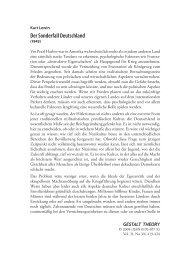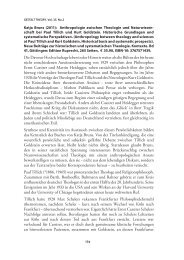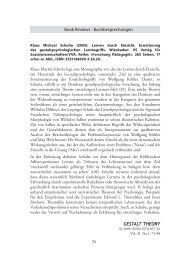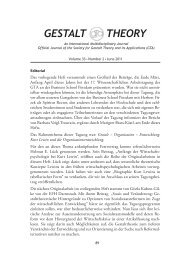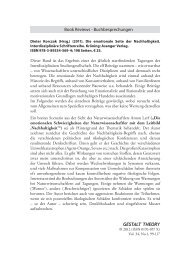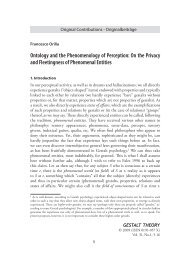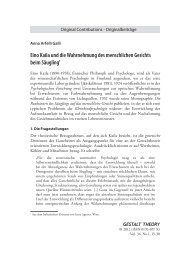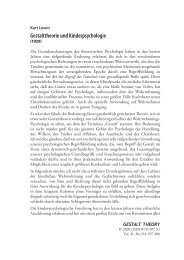What is the Meaning of Shape? - Gestalt Theory
What is the Meaning of Shape? - Gestalt Theory
What is the Meaning of Shape? - Gestalt Theory
You also want an ePaper? Increase the reach of your titles
YUMPU automatically turns print PDFs into web optimized ePapers that Google loves.
6. D<strong>is</strong>cussion and Conclusions<br />
415<br />
Pinna, <strong>What</strong> <strong>is</strong> <strong>the</strong> <strong>Meaning</strong> <strong>of</strong> <strong>Shape</strong>?<br />
In <strong>the</strong> previous sections, following <strong>the</strong> methods traced by <strong>Gestalt</strong> psycholog<strong>is</strong>ts,<br />
we studied <strong>the</strong> meaning <strong>of</strong> shape perception starting from <strong>the</strong> square/diamond<br />
illusion, which represents a problem for <strong>the</strong> invariant features hypo<strong>the</strong>s<strong>is</strong> and for<br />
any model <strong>of</strong> shape formation. Theories based on <strong>the</strong> role <strong>of</strong> frame <strong>of</strong> reference in<br />
determining shape perception were d<strong>is</strong>cussed and largely weakened or refuted in<br />
<strong>the</strong> light <strong>of</strong> a high number <strong>of</strong> new effects, demonstrating <strong>the</strong> basic phenomenal<br />
role <strong>of</strong> inner properties in defining <strong>the</strong> meaning <strong>of</strong> shape.<br />
On <strong>the</strong> bas<strong>is</strong> <strong>of</strong> <strong>the</strong>se effects, several shape properties were demonstrated. They<br />
are: (i) <strong>the</strong> sidedness and <strong>the</strong> pointedness, related to <strong>the</strong> sides and angles in <strong>the</strong><br />
case <strong>of</strong> squares, diamonds and polygons; (ii) <strong>the</strong> pointing involved mostly in<br />
<strong>the</strong> triangles; (iii) <strong>the</strong> headedness, i.e. <strong>the</strong> appearance like a head <strong>of</strong> a particular<br />
component within an irregular shape, in <strong>the</strong> case <strong>of</strong> a new kind <strong>of</strong> v<strong>is</strong>ual<br />
organization that we called “organic segmentation”; finally, (iv) <strong>the</strong> happening,<br />
i.e. <strong>the</strong> something that happens to a figure. Many o<strong>the</strong>r shape properties remain<br />
to be studied.<br />
These shape properties were demonstrated to underlie <strong>the</strong> whole notion <strong>of</strong> shape<br />
and to appear like second level shape meanings. They can be considered like<br />
transversal or elemental meta-shapes common to a large number <strong>of</strong> shapes both<br />
regular and irregular. They are like meaningful primitives, phenomenally relevant,<br />
<strong>of</strong> <strong>the</strong> language <strong>of</strong> shape perception.<br />
Th<strong>is</strong> suggests that <strong>the</strong> meaning <strong>of</strong> shape can be understood on <strong>the</strong> bas<strong>is</strong> <strong>of</strong> a<br />
multiplicity <strong>of</strong> meta-shape attributes. Therefore, <strong>the</strong> notion <strong>of</strong> shape can be<br />
phenomenally represented like a whole v<strong>is</strong>ual “thing” that contains a specific set<br />
<strong>of</strong> phenomenal primitive properties. In o<strong>the</strong>r words, <strong>the</strong> shape can be considered<br />
like <strong>the</strong> holder <strong>of</strong> shape attributes. As a holder it expresses and manifests <strong>the</strong> state<br />
<strong>of</strong> organization <strong>of</strong> <strong>the</strong> inner meta-shapes.<br />
Within <strong>the</strong> shape like a holder, <strong>the</strong> shape attributes are not placed all at <strong>the</strong><br />
same height within <strong>the</strong> gradient <strong>of</strong> v<strong>is</strong>ibility, i.e. some emerge more strongly<br />
than o<strong>the</strong>rs depending on a number <strong>of</strong> factors that can influence <strong>the</strong>ir vividness<br />
and thus <strong>the</strong>ir v<strong>is</strong>ibility. Among <strong>the</strong>m, we studied some known factors like <strong>the</strong><br />
horizontal/vertical axes, <strong>the</strong> gravitational orientation, <strong>the</strong> configural orientation<br />
and <strong>the</strong> large reference frame. We also demonstrated <strong>the</strong>ir limits and showed <strong>the</strong><br />
reason <strong>of</strong> <strong>the</strong>ir effectiveness under specific conditions. Within <strong>the</strong> hypo<strong>the</strong>s<strong>is</strong> <strong>of</strong><br />
<strong>the</strong> shape like a holder, <strong>the</strong>ir effectiveness depends on <strong>the</strong> accentuation <strong>of</strong> one<br />
specific meta-shape attribute. Therefore, in <strong>the</strong> case <strong>of</strong> a square, <strong>the</strong> horizontal/<br />
vertical organization <strong>of</strong> <strong>the</strong> sides accentuates <strong>the</strong> sidedness, while in <strong>the</strong> case <strong>of</strong><br />
<strong>the</strong> diamond <strong>the</strong> pointedness <strong>is</strong> accentuated by <strong>the</strong> same factor. Th<strong>is</strong> entails that<br />
a rotated square <strong>is</strong> perceived when <strong>the</strong> sidedness <strong>is</strong> stronger than <strong>the</strong> pointedness;<br />
o<strong>the</strong>rw<strong>is</strong>e we would have perceived a rotated diamond.





